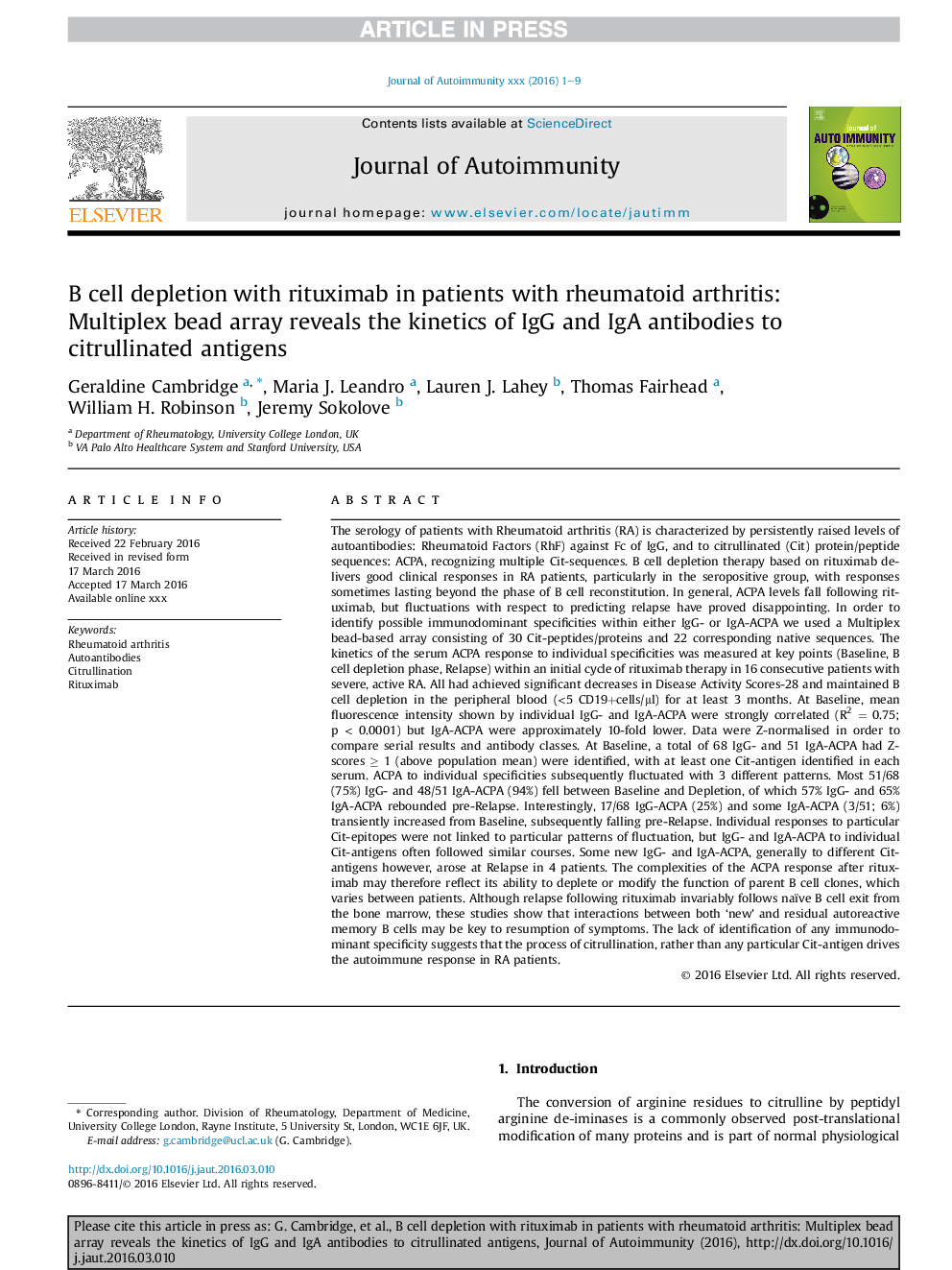| Article ID | Journal | Published Year | Pages | File Type |
|---|---|---|---|---|
| 6119110 | Journal of Autoimmunity | 2016 | 9 Pages |
Abstract
The serology of patients with Rheumatoid arthritis (RA) is characterized by persistently raised levels of autoantibodies: Rheumatoid Factors (RhF) against Fc of IgG, and to citrullinated (Cit) protein/peptide sequences: ACPA, recognizing multiple Cit-sequences. B cell depletion therapy based on rituximab delivers good clinical responses in RA patients, particularly in the seropositive group, with responses sometimes lasting beyond the phase of B cell reconstitution. In general, ACPA levels fall following rituximab, but fluctuations with respect to predicting relapse have proved disappointing. In order to identify possible immunodominant specificities within either IgG- or IgA-ACPA we used a Multiplex bead-based array consisting of 30 Cit-peptides/proteins and 22 corresponding native sequences. The kinetics of the serum ACPA response to individual specificities was measured at key points (Baseline, B cell depletion phase, Relapse) within an initial cycle of rituximab therapy in 16 consecutive patients with severe, active RA. All had achieved significant decreases in Disease Activity Scores-28 and maintained B cell depletion in the peripheral blood (<5 CD19+cells/μl) for at least 3 months. At Baseline, mean fluorescence intensity shown by individual IgG- and IgA-ACPA were strongly correlated (R2 = 0.75; p < 0.0001) but IgA-ACPA were approximately 10-fold lower. Data were Z-normalised in order to compare serial results and antibody classes. At Baseline, a total of 68 IgG- and 51 IgA-ACPA had Z-scores â¥Â 1 (above population mean) were identified, with at least one Cit-antigen identified in each serum. ACPA to individual specificities subsequently fluctuated with 3 different patterns. Most 51/68 (75%) IgG- and 48/51 IgA-ACPA (94%) fell between Baseline and Depletion, of which 57% IgG- and 65% IgA-ACPA rebounded pre-Relapse. Interestingly, 17/68 IgG-ACPA (25%) and some IgA-ACPA (3/51; 6%) transiently increased from Baseline, subsequently falling pre-Relapse. Individual responses to particular Cit-epitopes were not linked to particular patterns of fluctuation, but IgG- and IgA-ACPA to individual Cit-antigens often followed similar courses. Some new IgG- and IgA-ACPA, generally to different Cit-antigens however, arose at Relapse in 4 patients. The complexities of the ACPA response after rituximab may therefore reflect its ability to deplete or modify the function of parent B cell clones, which varies between patients. Although relapse following rituximab invariably follows naïve B cell exit from the bone marrow, these studies show that interactions between both 'new' and residual autoreactive memory B cells may be key to resumption of symptoms. The lack of identification of any immunodominant specificity suggests that the process of citrullination, rather than any particular Cit-antigen drives the autoimmune response in RA patients.
Related Topics
Life Sciences
Immunology and Microbiology
Immunology
Authors
Geraldine Cambridge, Maria J. Leandro, Lauren J. Lahey, Thomas Fairhead, William H. Robinson, Jeremy Sokolove,
